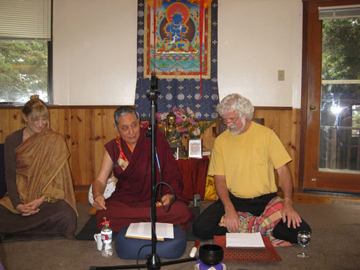Indo-Tibetan Buddhist Meditation-Level 3 Intensive Retreat
Daniel Brown, Ph.D.
with Senior Teacher: Rahob Rinpoche

Lama Palden, Thupten Kalsang Rinpoche, and Dr. Brown
The level 3 retreat is restricted to meditators who previously have taken the level 1 and/or level 2 Pointing Out retreat directly with Daniel Brown and least one time, who have had direct experience of awakened awareness, however unstable. Entry into the level 3 course is restricted to those students who have established an on-going relationship with one of the four teachers, and wherein the teacher has nominated the student for the level 3 course, based on level of realization. The level 3 course is designed specifically for students who have some degree of awakening, who wish to stabilize this awakening at all times in all situations, and who wish to then develop the positive qualities, conduct, and levels of awareness of a Buddha for the benefit of others. This course will focus on Great Completion (Dzogs chen) meditations, specifically derived from Garab rDorje’s Three Golden Letters, Longchen Ramjam’s Self-Liberated Mind, and Padma Sambhava’s Self-Liberation Through Seeing with Naked Awareness. A strong emphasis is on identifying conditions that cloud over awakened awareness in everyday life, such as thought, emotional states, and external appearance. The course will focus on: Dzogs chen by-passing instructions, establishing awakened awareness with definitive certainty at all times and in all situations, transforming ordinary consciousness into the five wisdom lights, original purity and appearances from the basis from the side of dharmakaya awareness, developing the positive states and conduct of a Buddha, and development of the Buddha-bodies.
The level 3course utilizes the same relationally-based Pointing Out style of teaching as in the level 1 course. More emphasis is given to mastery of the last three stages of concentration–automatic concentration, one-pointed flow, and equanimity. A traditional Mahamudra approach is taken to concentration. In the interval between the cycle of the rising and falling breath as the intended meditation object, instructions are given to rest the mind in its natural state, following Guru Yoga instructions. In that way, the view of the natural state of the mind is established and reinforced throughout concentration training. During the insight series of meditations, traditional Mahamudra meditations are used that stress emptiness of thought elaboration, emotional states, body and mind, and external appearance. Mahamudra emptiness of the three times meditation is added to traditional sutra emptiness of time meditation. Emphasis is given to establishing direct experience of automatic emptiness as a foundation for non-meditation instructions. Emphasis is given to expanding the range of advanced non-meditation practices, and to recognizing awakened wisdom.For those practitioners who have some direct experience of initial flames of awakened wisdom, but who have not yet stabilized the realization, Mahamudra path-walking instructions will be introduced. An emphasis is given to developing uninterrupted practice all of time in everyday life, instead of formal sitting meditation sessions, until realizing automatic emptiness on and off the meditation cushion at all times, without difference.
